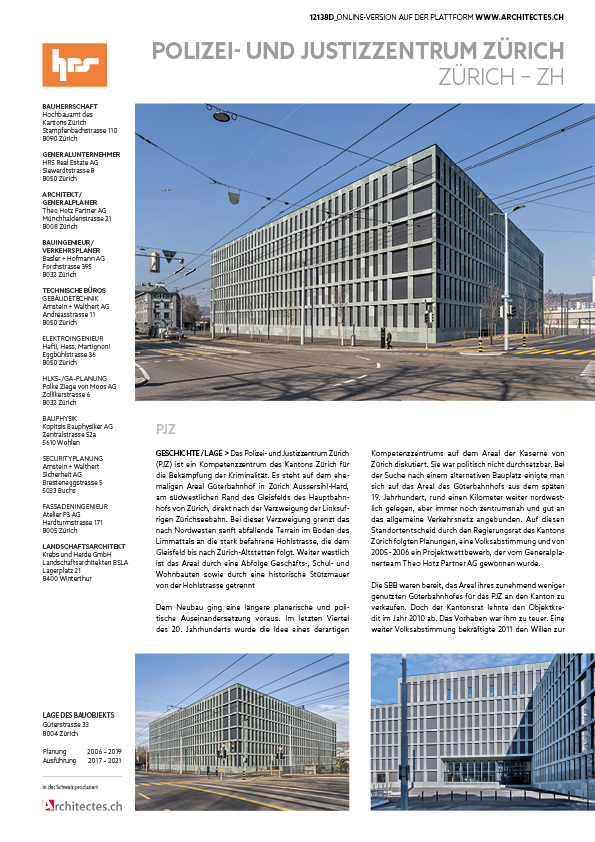Police and Justice Centre Zurich
Bâtiments administratif et commerces
Bâtiments administratif et commerces
HISTORY/LOCATION
The Police and Justice Centre Zurich (PJZ) is a competence centre of the Canton of Zurich specialised in fighting crime. It is located on the site of the former freight station in Zurich Aussersihl-Hard, on the south-western edge of the tracks at Zurich’s main railway station, directly beyond the junction for the Zürichseebahn train which runs along the left-bank. At this junction, the terrain, which slopes gently downwards to the northwest, borders onto the busy Hohlstrasse in the bottom of the Limmat valley, which follows the tracks all the way to Zurich-Altstetten. Further west, the site is separated from the Hohlstrasse by a succession of commercial, school and residential buildings and by a historic retaining wall.
The new building is the result of a lengthy planning and political debate. During the last quarter of the 20th century, discussions were held on the feasibility of building a competence centre of this type on the site of the Zurich barracks. However, it was not politically feasible. The search for an alternative building site led to an agreement on the freight station site dating from late 19th century and located about one kilometre to the northwest, but still close to the city centre and well connected to the general transport network. Following this decision on the location by the government of the Canton of Zurich, the next steps were planning, a referendum and, from 2005 to 2006, a project competition, which was won by the general planning team Theo Hotz Partner AG.
The SBB were prepared to sell the site of their increasingly underused freight station to the canton for the PJZ. But the cantonal council rejected the construction budget in 2010. The project was too expensive. Another referendum in 2011 confirmed the will to complete the project, and in 2012 the cantonal council finally approved the necessary construction budget. A few months later, the Federal Supreme Court dismissed the last of the appeals, which were primarily directed against the demolition of the historic freight station. In 2013, the property was purchased from the SBB, clearing the way for the implementation of the 2006 competition project. In 2017, HRS Real Estate was awarded the contract to build the PJZ as general contractor with full cost, quality and schedule guarantees.
CONCEPT/ARCHITECTURE
The PJZ houses units of the Cantonal Police, the Public Prosecutor's office and the Penal Authority, as well as the Forensic Institute, the Zurich Police School and parts of the Compulsory Measures Court. It provides 2030 workplaces. In addition, there are 241 detention places for provisional arrests as well as detention pending trial.
It is a compact, closed structure with a concrete skeleton construction, comprising six to seven storeys above ground. Its exterior façades follow the contours of the site to the north, east and south of the plot. In the southeast corner, they form a large, irregular polygon projecting from the former track bed which, from Hohlstrasse, appears as a head-end building. Further northwest, the complex changes into an orthogonal structure with a rectangular floor plan. Here, the building is aligned with the former freight station tracks. The main entrance is located on the south side, at the junction between these components. It lies slightly lower than the Hohlstrasse at the end of a gently sloping ramp and leads into a large, seven-storey atrium with staircases, which towers above the main structure and is surrounded by high-ceilinged conference rooms on the top floor.
Inside the building, three large, landscaped courtyards open up to the skies. They divide the PJZ into different three-span office wings and provide the adjoining rooms with plenty of daylight. Under one of them is the extensive staff restaurant, which is divided up by small, organically shaped patios planted with greenery. Since the boundary of the courtyards runs parallel to the outer façades, they differ substantially in shape, which makes navigation easier. In addition, there are four identical small rectangular prison courtyards in the northern wing containing cells. In the northwest corner, a landscaped inner courtyard of almost 4,000 square metres for staff is incorporated into the overall volume on the ground floor level. There is also access on the north side, directly adjacent to the tracks, to the first of three basement floors (at ground level due to the sloping terrain). This leads past a checkpoint to a hall one level below. In addition to offices and training rooms, the versatile space includes firing ranges, a forensics or operations centre and a sports hall under the large inner courtyard.
The architecture is strongly influenced by the issue of security. For instance, there were very high requirements in terms of preventing break-ins and break-outs. A great deal of attention also had to be paid to sound insulation due to the various adjacent uses and the high level of confidentiality required in the interrogation rooms. The fact that 300 project changes were made during the construction shows how complex the task was.
From the outside, the building, which has over 4,000 doors, looks like a fortress. In terms of design, this is expressed in the standardised stone relief façade on all sides. It was designed using a basic element that combines the load-bearing pillars and slab faces to create a façade with a strong effect on the space. The decision was made to use the green-grey Swiss “Verde Salvan” natural stone, a conglomerate rock with a dynamic structure and colour nuances. Its enormous strength made it possible to achieve the desired three-dimensional, sharp-edged geometry of the PJZ façade.
ENERGY EFFICIENCY/SUSTAINABILITY
The PJZ was pre-certified according to Minergie-ECO® during the planning phase. Renewable ambient energy is predominantly used to cover the energy, heating and cooling requirements. A photovoltaic system on the roof with a peak output of around 350 kW, four waste heat/groundwater heat pumps with a thermal output of up to 4,000 kW, the use of waste heat from the computer centre and the IT rooms, and heat recovery in the ventilation systems all contribute to resource-efficient operation. The complex also has four recooling plants for “freecooling” (cooling energy from the outside air).
 Accès membres
Accès membres

 Page précédente
Page précédente



